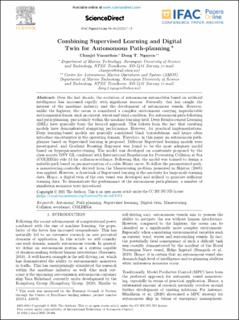| dc.description.abstract | Over the last decade, the evolution of autonomous automobiles based on artificial intelligence has increased rapidly with significant success. Naturally, this has caught the interest of the maritime industry and the development of autonomous vessels. However, unlike the highway, the ocean is considered a complex environment carrying unpredictable environmental forces, such as current, waves and wind-condition. For autonomous path-following and path-planning, particularly within the machine learning-field, Deep Reinforcement Learning (DRL) have generally been the favored approach. This follows from the fact that resulting models have demonstrated staggering performance. However, for practical implementations, Deep learning-based models are generally considered black box-solutions, and hence often introduce uncertainties in the operating domain. Therefore, in this paper an autonomous path-planner based on Supervised learning is proposed. Different Supervised learning models were investigated, and Gradient Boosting Regressor was found to be the most adequate model based on hyperparameter-tuning. The model was developed on constraints proposed by the class society DNV GL combined with International Regulations for Preventing Collision at Sea (COLREGs) rule 14 for collision-avoidance. Following this, the model was trained to design a suitable path based on parametrization of a cubic Bézier curve. To follow the parametrized path, a maneuvering-controller derived from the Maneuvering problem presented in Skjetne (2005) was applied. However, a drawback of Supervised learning is the necessity for large-scale training data. Hence, a digital twin of the own vessel was developed and utilized to generate sufficient training data. To demonstrate the performance of the autonomous path-planner, a number of simulation scenarios were introduced. | en_US |

